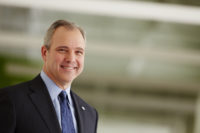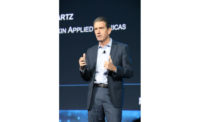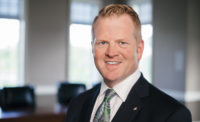Every successful project starts with a framework. A vision statement. A blueprint. The editors of Engineered Systems are proud to present The Blueprint — a monthly Q&A interview with HVACR engineering’s leading voices. These one-on-one discussions will examine the trade’s history, current industry trends, the factors shaping the sector’s future, and more.
Smart infrastructure supports the way we all want to live – happily, comfortably, sustainably, and in harmony. It supports the way industry and organizations want to be — efficient, responsible, and smarter.
Smart Infrastructure from Siemens intelligently connects energy systems, buildings, and industries to adapt and evolve the way communities live and work. Siemens works together with customers and partners to create an ecosystem that intuitively responds to the needs of people and helps customers to better use resources. It helps the company’s customers to thrive, communities to progress, and supports sustainable development.
In this interview, Herb Woerpel, editor-in-chief of Engineered Systems, sat down with Dick Pope, segment head for connected devices and application center of competence at Siemens Smart Infrastructure USA discusses connected devices, smart infrastructure, the future of American buildings, and more.
Engineered Systems: Siemens is among the industry leaders in building automation, and it’s an honor to have you with us, Dick. Please take a moment to introduce yourself and share a little bit more about your role with Siemens.
Dick Pope: My name is Dick Pope, and I’m the segment head for connected devices and application center of competence at Siemens Smart Infrastructure USA. I’ve been with Siemens for eight years. Working at Siemens, I truly enjoy creating and executing product strategies that make a positive impact in energy savings and optimizing the overall performance of HVAC equipment systems.
Engineered Systems: You lead the connected device segment. What kinds of connected devices do you oversee?
Pope: Our products include damper actuators, valves, variable frequency drives (VFDs), thermostats, sensors, meters, and lighting solutions.
Engineered Systems: And that team is part of the Building Products group, which is part of the Smart Infrastructure operating company. What else falls under Smart Infrastructure – and how, at a high level, do they all work together?
Pope: Smart Infrastructure brings together building technologies and energy systems. This spans from the intelligent control across the grid to medium-voltage substations through a broad range of low-voltage and control products and the point of consumption to climate control, fire and security, and distributed energy systems, to name a few.
Engineered Systems: Indoor air quality continues to be a big focus for everyone. What kinds of measurements should HVAC engineers/facility managers pay particular attention to?
Pope: IAQ risks specific to HVAC systems can include under-heating, failure to cool, or inadequate ventilation. Improperly functioning HVAC systems not only impact operational costs but present several challenging issues including potential lawsuits for unhealthy work environments and employee well-being, impacting productivity and quality of work. Poor air conditions or lack of comfort can also lead to a poor image for the building manager/owner, loss of tenants and business, or high employee turnover rate. When HVAC systems are not functioning properly, conditions can diminish rapidly, such as mold (high humidity), lack of fresh air (poor ventilation and dirty filters), high levels of particulate matter (filters not being replaced), and the inability to meet temperature set points. It’s increasingly important to proactively monitor air quality attributes, including carbon monoxide, carbon dioxide, particulate matter, temperature, humidity, and air pressure. Sensors placed within critical areas of the building are key to monitor system performance.
Engineered Systems: One of the main solutions you recently helped bring to market is the Climatix rooftop unit. Can you tell us a little about it: What it is, how it works, and how it helps indoor air quality?
Pope: The rooftop unit is the among the most widely used HVAC equipment across several building types throughout North America. With millions installed and a high percentage not having the latest technology, we created a system solution to be used by RTU original equipment manufacturers for new units and HVAC contractors to retrofit aging equipment. This solution is a combination of sensors, damper actuators, and VFDs that is connected to the Siemens Climatix controller serving as the “brain” of the system. This easily configured solution provides an exceptional user experience for installation, commissioning, and monitoring through our mobile app and cloud remote management solution. The sensors are strategically located within the RTU and room to monitor filter status, CO2, humidity, and indoor temperature to ensure a healthy and efficient system. The combination of damper actuators and the controller also support air purge that can be scheduled at any frequency or on demand. The purge increases fresh air indoors while exiting existing contaminated air from the building.
We also customized the Climatix VFD as an easy plug-and-play solution with commissioning taking minutes, not hours. The VFD provides improved energy efficiency and fan speed management for proper airflow. We also built in the Title 24 economization application to take advantage of free cooling when conditions are conducive.
The system can be monitored remotely with alarms/notifications being provided should air quality or HVAC operation surpass critical set points. The solution not only provides peace of mind for occupants that the building is healthy and safe, but, also, the cloud-based options allow service companies to troubleshoot and deliver system updates without the need to roll a truck. This is truly a winning solution that delivers improved efficiency and 24/7 air quality monitoring to ensure a healthy facility.
Engineered Systems: Would you say it’s an industry changer? If so, how?
Pope: Yes, this is an industry changer. Our engineers have delivered an equipment-based building automation system without the complexities or cost. It is designed to improve RTU energy efficiency and operation that includes the measure of air quality and even tells users when the air filter needs to be changed. This is not only innovative but needed in buildings that, in many instances, are not properly maintained or ignored until a problem occurs. A proactive approach to equipment management and optimization that can be monitored remotely provides peace of mind and saves mechanical service companies time and money while ensuring a healthy and comfortable environment for their customers. In this age, where more buildings are seeking ways to ensure a healthy tenant environment, this is a budget-friendly solution for the building owner and an efficient solution for contractors to offer.
Engineered Systems: What do you think will be the next big thing with HVAC systems/controls? Maybe this is something that’s still on the horizon or something that isn’t being used prevalently right now but might become more commonplace five, 10, or 20 years from now.
Pope: Equipment-based automation will continue to evolve for both new equipment and retrofit solutions; however, it will not just be a smart controller or individual end device. Engineered equipment systems will work in harmony to continually improve operation, efficiency, and healthy environments. Past learnings from occupant preferences and equipment operation are already being used to improve ways to remotely identify problems and pinpoint the part that needs to be replaced/repaired as well as continued improvement of operation. New technologies to tackle these challenges will see continued leaps in progress during the upcoming years.
Engineered Systems: We keep hearing about – and are starting to see – a retirement bubble of HVAC technicians. What can you say to help encourage the newer generation to enter this field?
Pope: The younger generation has been raised on technology. They are using cloud and digital solutions every day. This experience can be used with the new technology we are witnessing in HVAC equipment. Those who enjoy technology want new challenges every day. They don't want to be behind a desk, and HVAC is an incredible and satisfying career in that aspect. Being able to solve problems, make people happy and earn a great living is a great combination.
Engineered Systems: If you could leave HVAC engineers/facility managers with one piece of lasting advice, what would it be?
Pope: Have an open mind and embrace new approaches in solving old problems. We all become comfortable and regimented in the way we do things, and it’s difficult to change as we can interpret change as risk. However, new technologies have provided better solutions and user experiences that will not only provide better results but increase personal value to your customers or employer.
Engineered Systems: Dick, thanks again for your time. We look forward to continuing to track Siemens’ evolution. If readers are interested in connecting with you, where should they turn?
Pope: Thanks for having me. I can be reached at Richard_pope@siemens.com.





